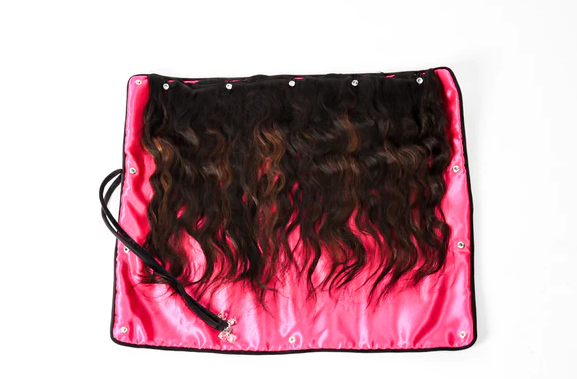Judge Shequitta Kelly, Creator Of The Hair Shield, Talks Balancing Career With Entrepreneurship

Judge Shequitta Kelly enjoys a career in which she can make a difference and shift the narrative of what coming before a judge really means. “I am always motivated every day by the desire to help the people I see in front of me. I have a lot of people who come from humble beginnings who have parents that have made some really poor decisions and they have no support system,” she said. “They have no job and really, crime is what they turn to. They meet me and I end up being the first one who pours into them and encourages them to live a better life and make better choices. When I see that my words have actually made a change in someone’s life, which in turn is helping the community overall, that motivates me.”
Kelly decided to take a step into the entrepreneur pool simply because she saw a need in her own life to accommodate her love of changing up her hairstyles. As a busy mother of three and a judge who handles cases of violence in homes including partner violence, sibling rivalry, and parent-child violence, she sought a method of storing her hair extensions that would be effective and save her time and money. In 2018, she officially introduced her product, The Hair Shield, to the market, a savvy, stylish, and convenient way to store hair extensions to ensure their longevity.
Her Agenda talked with Kelly about her foray into entrepreneurship, how she balances being a wife and mother with the launch of a startup, and her advice for millennial women who love their 9-to-5s and want to become successful business owners:
Her Agenda: How did the idea for The Hair Shield come about and how has it been received in the market?
Judge Shequitta Kelly: The idea came from the way I was raised, to be honest. I grew up in a lower-economic neighborhood, single-parent home where money was tight and I always heard ‘Money don’t grow on trees.’ Even today, as I have reached a certain level of success, I’m always saving and [working to ensure I’m not] throwing away money. I noticed that I was being a hypocrite to my own word [via] my haircare. I love extensions, and I love to switch up my hairstyles but I realized that I was spending all this money on them and then just throwing them out when it was time to get my hair redone. I’d just go buy all new and spend all that money again, plus what it cost to get it installed.
These companies were [advertising that] this hair was supposed to last for years, but I was getting one hairstyle out of them. What’s going on? I thought, ‘I’m probably not storing them right. I need to put them in a better place instead of the Walmart bag or the Ziploc bag.’ Sometimes I was just throwing the hair in my drawer where the brushes and combs were. I decided I was going to do better.

I started Googling ‘hair storage’ or ‘bundle storage’ and the only thing that would come up was those hangers—I didn’t want to do that—and the little bitty plastic garment bags. I knew, with the way I was raised, that you’re supposed to sleep with satin on your hair. I sleep with a satin scarf, my daughter sleeps with a satin bonnet, and my mom sleeps on a satin pillowcase. I’m not a beautician, but I knew that putting 100% human hair in a plastic garment bag just didn’t line up to me.
I [thought] ‘I know how to sew. I’ve made clothing before. Let me see if I can make something out of a satin pillowcase to put my hair in.’
I just put together this little makeshift item and put my hair in there, and then I kept using it. I realized, after doing that, I hadn’t bought new hair in a year and if I did, the hair wasn’t the same. I might have wanted to do curls or something.
I was sharing with my girlfriends and they said, ‘Make me one.’ They encouraged me. I have five friends who work in apparel merchandising and they were like, ‘You could be making a profit off of this. You need to find a designer to make a prototype and get a patent. Women need this.’
At their urging I decided to do it. [It] has been difficult and costly, but I’ve learned so much and it’s caused me to be much more disciplined, not only in my entreprenreial life but in my day-to-day professional life, too.
At first it was just my friends and sorority sisters buying it. That was great, but I wanted to figure out how to get people who don’t know me to buy it.
Now, I have more people, initially African American women, started buying them. To me, that is success, when you have strangers believing in something you created in your home. Once I [launched] on Etsy, I [began attracting] white women who buy it, and they’re repeat customers.

What was your strategy to go from just your friends buying to having other customers?
I did a combo of things. I made a lot of costly mistakes, like having someone with a large social media following to post the Hair Shield on their page, which now I know that some people do that and they bought followers, so that doesn’t equate to sales.
I did a lot of social media marketing after hiring a social media company two-and-half years ago. I got a lot more engagement and more clicks to my website and more purchases based on that marketing company putting up ads. I was able to read comments where women are saying “Oh my God, where has this been all my life?” or “You need this,” and they’re tagging their friends. It helped my [confidence] because with entrepreneurship you take a lot of blows to your ego.
It helped to know that people do like this. This isn’t just something you thought of and your friends are hyping you up.
The downside of it was that it was really hard, even with a marketing team, to get people to understand what it was just from a photo. They saw it as just this rolled up piece of satin, and you’ll just scroll right past that. I had to [start] marketing [with] video.
What were three keys in terms of discipline in order to balance your 9-to-5 with reaching your entrepreneurship dreams or pursuits?
Write the vision and make it plain. Throughout my life, whether it was balancing a 2-year-old while I was in college and carrying 16 credit hours [or] running a program for inmates in my court, I have always written down my ultimate goal and how I’m going to get there.
I have books and planners all over the place, and pieces of paper, stuck inside books, that I have written down the goal, and then I’m like, ‘How am I going to do that?’
Then, schedule each task in order to meet your goals. Write what month [or] what week you’re going to do something. Now, I write things down daily. That is the only way I can juggle a full-time job and family and a business that I run by myself.
Second, limit social media. You can’t expect to meet all these goals if you’re scrolling, on average, two to three hours a day. I have made sure I set times to check social media. I check in the morning after I’ve gotten up and washed my face and done my morning routine. I may check at lunch if I have not scheduled something for myself at that time, and then I check at the end of the day after I’ve done my family time and I’m winding down.
Social media, for me, was a big problem because I love laughing! TikTok! Oh my God, I can’t get out of that without clicking through 50 million times! It just sucks you in and then next thing you know, an hour has gone by. You could have used that hour to do so many other things.
Third, seek work-life balance. I am able to stay more disciplined when I know I can also have fun. I plan my fun. It makes me more balanced and disciplined because I get to play.






